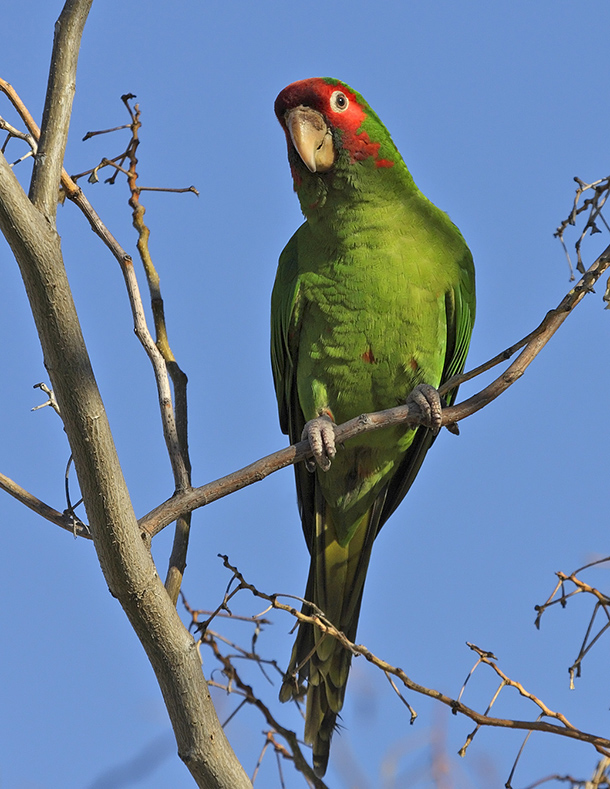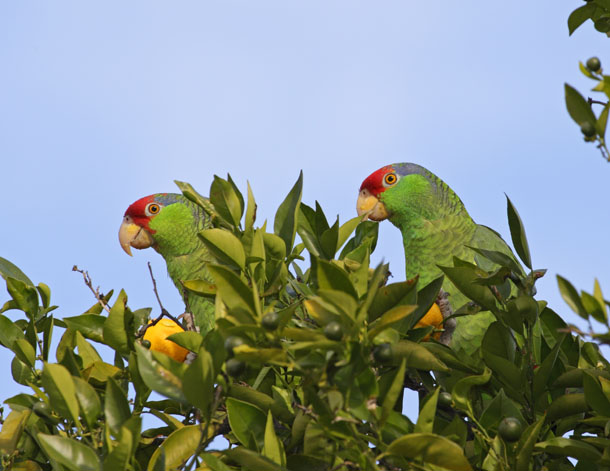California’s WILD Parrots

Feathers of Hope: The Parrots’ Uplifting Struggle and Success
Embark on an emotional rollercoaster with the story of the parrot, a symbol of the pressing conservation challenges we face today. As their native populations plummet, conservationists worldwide are fiercely battling to protect these captivating birds and curb the global trade and smuggling of wild-caught parrots. Yet, in a miraculous twist, certain parrot species have audaciously announced their presence right here in the United States. Far from their native habitats, wild flocks can be found in California, Texas and Florida.
In California, whispers of the past tell of a daring escape when a notorious bird smuggling ring met its match, leading to the spontaneous release of their captive birds. In another riveting episode, courageous firefighters, responding to a pet shop crisis, chose to set the birds free rather than witness their demise. These urban legends have intrigued and mystified for over 50 years, but the real story is even more spellbinding.
The wild parrots that now soar through the skies of Southern California are the proud descendants of those once imported or smuggled and subsequently escaped or were released. These survivors, adept at fending for themselves, found refuge in areas rich in exotic flora. It’s a widespread myth that companion parrots can survive in the wild; in truth, their success rate is minimal. Without the vital survival skills such as flight endurance, understanding of flock calls, and essential lessons taught by experienced adult parrots, their chances are bleak from the outset.
Historical records trace the presence of wild parrots in Southern California back to the 1960s, with some indicators suggesting they may have been here long before. Their mysterious origins only add to the intrigue of their story – a narrative of perseverance and adaptation.
Having heard of the wild parrots in the early 1980s, it wasn’t until 2001 that we set out to find them. Little did we know an excursion of curiosity would turn into a passion we couldn’t resist. Though we have visited most flocks in Southern California, it was clear that to accomplish our desire to learn everything about them; to learn the who, what, when, where and why of it all, we would have to focus on our two local flocks. Daily visits and often three times a day became routine. We grew to know individual members of the flocks, even naming some of them and recording their lives. We learned their habits, their personality; we watched them choose a mate and we watched their babies fledge and grow. And we lost some along the way.
While this website is focused on our two local flocks, they are representative of other flocks in Southern California. We invite you to witness how these resilient, naturalized psittacines have claimed the skies, wires, and trees of Southern California as their own, their numbers increasing each spring. Their successful adaptation to the urban environment is a testament to the enduring spirit of nature.
Delve into their world at californiaparrots.com for an intimate and inspiring look at their lives.
In California, the most commonly seen wild parrots are:
- Red-crowned Amazon (Amazona viridigenalis) or Red-crowned Parrot
- Lilac-crowned Amazon (Amazona finschi) or Lilac-crowned Parrot
- Red-lored Amazon (Amazona autumnalis) or Red-lored Parrot
- Mitred Parakeet (Psittacara mitratus)
- Red-masked Parakeet (Psittacara erythrogenys)
- Blue-crowned Parakeet (Psittacara acuticaudatus)
- Rose-ringed Parakeet (Psittacula krameri)
- Yellow-chevroned Parakeet (Brotogeris chiriri)
- Black-hooded Parakeet (Aratinga nenday)
Less commonly seen are:
- Yellow-headed Amazon (Amazona oratrix) or Yellow-headed Parrot
- Turquoise-fronted Amazon (Amazona aestiva) or Turquoise-fronted Parrot
- White-fronted Amazon (Amazona albifrons) or White-fronted Parrot
Why do the Amazons have two names?
We are frequently asked this question and there is no clear answer; Red-crowned Amazon versus Red-crowned Parrot? You decide:
The term “parrot” is very broad and is used to describe a large number of species that make up the order Psittaciformes in more than 90 genera. Common names can often be misleading and unrelated to taxonomy. Take a quick look at the list to the left and the term “parakeet.” How many genera do you find that include “parakeet” in their common name that are unrelated? How many of the six species of genus Amazona do you find that are unrelated?
When you have the perfect common name that follows the taxonomy (e.g. Red-crowned Amazon), why would you change it? For this reason, we have chosen to use the common name that follows the taxonomy.
For the most part, flocks in California are species specific such as the Black-hooded Parakeets of Malibu; the Yellow-chevroned Parakeets of Los Angeles; the Rose-ringed Parakeets of Bakersfield; the Red-masked Parakeets of San Francisco – but the largest in number are the Amazon flocks, they are also the exception in that Amazon flocks have a variety of species among them. Flocks of Amazon parrots can be found in Los Angeles, Orange, San Bernardino, Riverside, San Diego, Ventura and Santa Barbara Counties — the most numerous of which, call the greater Los Angeles area their home.
Some of these parrots would never catch a glimpse of each other in their native ranges, but here these species have become dedicated companions, bonded friends and flock-mates.
Endangered Species

In their native ranges, three of these Amazon species are in serious trouble. Designated a threatened species in 1988, the Red-crowned Amazon was added to the IUCN Red List of Endangered Species and was upgraded to an endangered species in 1994. Still declining in its native range due to exploitation and long-term habitat loss, only small populations of Red-crowned Amazons remain. It is now believed that more Red-crowned Amazons exist in the United States, than in their native range.
In 2004, the Lilac-crowned Amazon was placed in CITES Appendix I by the Convention on International Trade of Endangered Species as vulnerable. Renton and Elias (2003) estimated the global population at 7,000-10,000 individuals, which steadily continues to decline due to exploitation and habitat loss. In 2008, the Lilac-crowned Amazon was upgraded to endangered.
Though relatively few Yellow-headed Amazons are found in California, they are breeding. Listed as an endangered species in 1994 with a then native range population estimated at only 7,000 birds, rapidly decreasing numbers continue.
Certainly, if these trends continue and unless there are drastic changes in their native ranges, these birds’ greatest chance for survival may be right here in the United States.
It is a twist of irony that while man was so depleting some of these birds in their native ranges, he was also unknowingly creating an ideal environment for them to survive elsewhere. Though only certain species have “made it” here — there surely must be some poetic justice underneath it all.
One thing is certain, the wild parrots are here to stay.

*ICUN Red List – International Union for Conservation of Nature – Red List of Threatened Species
**CITES – Convention on International Trade in Endangered Species of Wild Fauna and Flora
Learn more about some of California’s Wild Parrots…

